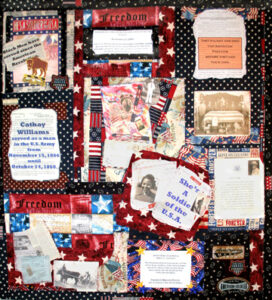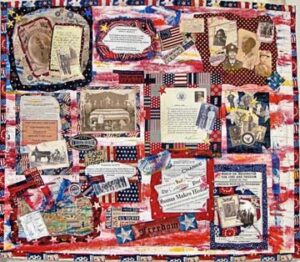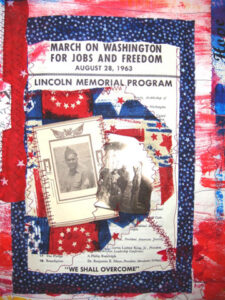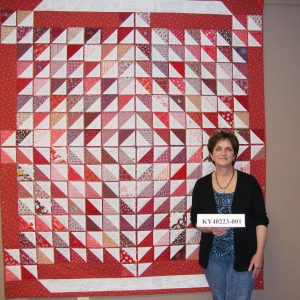This veteran’s day, we’re sharing two quilts that honor veterans in very different ways. One honors a generation of soldiers through documents and photographs, and the other is a quilt for a single serviceman: a story of a son’s journey to Afghanistan and the quilt his mother made for him.
We’re starting with a quilt from Carol Lyles Shaw. Here’s an excerpt from her 2009 interview with Karen Musgrave:



Karen Musgrave (KM): This is Karen Musgrave and I am conducting a Quilters’ S.O.S. – Save Our Stories interview with Carole Lyles Shaw. Carole is in Columbia, Maryland and I’m in Naperville, Illinois so we are conducting this interview over the telephone. Today’s date is January 18, 2009. It is now 10:55 in the morning. Thank you so much for agreeing to do this interview with me. Tell me about your quilt “War and Freedom: African Americans Veterans Hail the Commander-in-Chief, #2.”
Carole Lyles Shaw (CLS): Thank you Karen, I’m thrilled to be talking about this particular art quilt this particular weekend, what could be more fitting just two days before the inauguration. This quilt is part of a series of quilts and other mixed media art work that I am creating to honor the memories of ordinary men and women who served in the American Armed Forces, particularly in the early part of the 20th Century and most of the work features images and documents and so forth from 1960 or earlier. I do have some work that will also focus on Vietnam and etc. that will be coming in later work. This particular quilt is scheduled to be in an exhibit that will go up in February 2009 and the exhibit [“President Obama: A Celebration in Art Quilts,” will be from February 9 to March 5, 2009 in the main gallery (King Street Gallery) of the Morris & Gwendolyn Cafritz Foundation Arts Center, Silver Spring, Maryland.] was organized by Sue Walen who had made a quilt documenting or celebrating the inauguration of Barack Obama and then decided in November 2008 to see if she could quickly organize a quilt show because she knew other people were doing similar kinds of works. Miraculously she was able to make that happen and I was one of the people who helped her reach out to people and so forth. This particular piece I actually did not have in progress when she called me. I was doing another piece that I will talk about later on in the interview. But I said, ‘Yes, I will make a piece for this show. I think it is important to have as much art work celebrating this moment in history as possible.’
Now the piece itself is not in any way a portrait of Barack Obama. In fact in this piece, there is no image of him. For me as an artist, what I wanted to do in the art works that celebrate the inauguration is mark the transitional importance and the transformative importance of his election, of his whole candidacy and its meaning to this particular group of African American men and women. People who served in the Armed Forces in the 1940’s and even the 1930’s in some cases are still alive and watching this. Either they are going to come to [Washington.] D.C. and celebrate it as some of the Tuskegee Airmen might do or they will watch it like the rest of us on our TVs warm in our homes on Tuesday. I really wanted to show that there was a group of men and women who would salute Barack Obama as the Commander and Chief of the Armed Forces, which is of course one of his Constitutional roles. In this piece, it is a very dense and content and image rich quilt. It is not very big. It is about 36 inches by 40 inches. What I’ve done is I’ve transferred photographs onto fabric and some of these photographs are from my family collection that I have of my father, my uncles and some of their friends. I have a letter that was sent by the White House to my father thanking him for his service in the Armed Forces and that letter dates to probably the late forties or early fifties. I found the actual letter in my grandmother’s house when I cleaned it out after her death. I had photographs of that type but then I’ve been scouring eBay for a couple of years now buying photographs and documents and metals and I even have a uniform and these are all memorabilia from African American families that have just been tossed away and someone found them when someone’s estate was being cleared out or whatever and they are selling this stuff on eBay and most of it was really, really inexpensive. I have a lot of photographs and I have letters that people sent to their families and their medals and all kinds of things, so I’ve selected a few of those photographs and they are also on this quilt as photo transfers onto fabric. Then I also have some memorabilia and words and so forth that are about the election. I have the absentee ballot that I sent in. A copy of it of course since the original was filed, but I made a copy of it because I was thinking about, ‘You know, I want to keep this some how,’ and I have a copy of my ballot in this quilt. I have some newspaper headlines. One that says ‘Obama Makes History’ and I have words like ‘freedom’ and ‘on the wings of hope’ and the word ‘vote’ and an image of the map of the mall where the swearing in will take place and the presidential parade and so you see a glimpse of that in this quilt. Then I also have a copy of the presidential order signed by Harry Truman in 1948 that desegregated the Armed Forces. I happen to have been born in 1948 so in my lifetime literally we moved from a legally segregated army to a desegregated army although for many years there was still lots and lots of discrimination and limitations of roles that African American men and women could play. I downloaded the first page of Truman’s executive order and I superimposed over that these words, ‘They fought and died for American freedom before they had their own’ and those words, those are my words and to me it just captures once again the honorable service that African Americans have given since the Revolutionary War obviously, even though at the time of the Revolutionary War we were still enslaved legally. Following the Civil War we were legally free but not full citizens. That took many, many more years to happen, and now we have an African American supported by Americans of all colors and walks of life who will be inaugurated into the White House in a couple of days. Some of the words on my quilt are ‘land of liberty’ and ‘stars and stripes’ and ‘on the path to change. Those words, those themes are what I wanted to convey. It is a narrative quilt, a story quilt almost but you’ve got to kind of read it slowly to get the full story.
The last piece of documentation that is on here is a copy of the program for the March on Washington [D.C.] at which Dr. Martin Luther King gave his “I Have a Dream” speak and there is a copy of that in this quilt as well. There is a lot of stuff here, personal history, history of people of names I will probably never know because these were just photographs and other memorabilia I bought on eBay. When I was invited to this show as well as to another Obama quilt show which is up right now in Washington, D.C., at first I was thinking, ‘What am I going to do? What will be the message I want to convey?’ I wanted to do something that would link the past to the present and point towards a different future. I knew I didn’t want to do an Obama portrait and I didn’t want to do anything that really just repeated the now familiar iconography that we see everywhere in terms of Obama memorabilia. I wanted to do something that was much more personal and thoughtful about our history as a country and the honor and service and hope that African Americans have had all their lives and throughout the history of this country. I think I will pause there for a moment.
 KM: Before we talk about the other quilt, #1, [“War and Freedom: African American Veterans Hail the Commander-in-Chief, #1.”] what are your plans for this quilt?
KM: Before we talk about the other quilt, #1, [“War and Freedom: African American Veterans Hail the Commander-in-Chief, #1.”] what are your plans for this quilt?
CLS: I hope that the show will also travel and go to other venues along with the other quilts in the show, not just my quilt. Beyond that, I have another piece in this whole series that is about African American women that are in the service, not about the inauguration but it is part of the War, Honor, Freedom series that is already traveling in a show. My hope is that this, these pieces along with some of the other mixed media pieces that I’ve done on African American veterans and their service, that some day I will have a show with all of those pieces in the show. I’ve done an artist book already and I’m thinking about doing a second book that I would actually print in a larger series. That book I would take sections or portions of each of these quilts and other pieces and write an essay essentially illustrated by shots from the various quilts and the other art work to really tell the story in my own words and what it means to me, but that is a longer term project.
KM: Tell me about “War and Freedom: African American Veterans Hail the Commander-in-Chief, #1.”
CLS: Sure. #1 is the quilt that I started when I was invited by Roland Freeman with the assistance of Dr. Carolyn Mazloomi [exhibit “Quilts for Obama: Celebrating the Inauguration of our 44th President,” at the Historical Society of Washington, D.C. from January 11 to January 31, 2009.]. Roland, almost at the same time as Sue Walen, decided to mount a show of Obama Inauguration celebration quilters in [Washington.] D.C. and he was able to secure the [Washington.] D.C. Historical Society building. His show was opened the second week of January, so it is up during the inauguration which is, of course, very thrilling. This piece has the same type of imagery and in fact some of the same images are in both quilts. The first quilt focuses more on the veteran and less on the inauguration event itself. There is no map of the inauguration, etc. I do have some relevant words on it. One of the patches in this quilt is a transcription of the Article 2, Section 2 of the Constitution which says the President shall be Commander and Chief of the Army and Navy of the United States and all the militia of the various states, etc. That is in this quilt surrounded by some fabric that’s wavy red, white and blue flags, the American flags. Another large patch in this quilt brings the service of women veterans a little bit more prominently. I have a couple of photographs, one from the sixties, more Vietnam era and one from World War II and over it I’ve got the letters transcribed that say, ‘She’s a soldier of the U.S.A.’ Now that is playing off another patch in this quilt. I bought some old sheet music, really old sheet music and on the front of the sheet music you see some soldiers marching carrying flags, U.S. flags, and the title of the song is ‘He’s a Soldier of the U.S.A.’ and I often in these works will play on ‘He’s a Soldier of the U.S.A.’ and ‘She’s a Soldier of the U.S.A.’ African American women have not seen the kind of attention, as people talk about the history of African Americans in the military, so I’m trying to bring that history a little bit more to the forefront. I have from very precious memorabilia from women soldiers that was really hard to find but once again I found it all on eBay.
There was also another piece of African American military history that I have in this quilt that is about women. There was a woman whose name, there is some dispute about her name but generally she is known as Cathay Williams who served as a man. She was an African American woman who disguised herself as a man and actually enlisted in the U.S. Army during the Civil War. She served for about two years before she became ill and was injured and was mustered out in 1868. It wasn’t discovered who she was, or that she was a woman until she applied for her pension many years later and then it was discovered that she was not a man, William Café, which is how she enlisted but she was Cathay Williams, a woman and there were other women that we know who served in the Civil War and disguised themselves as boys or young men and enlisted. There are probably more that we will never know because they died or they mustered out and no one ever knew. She is one that has been documented so it is known. These two pieces have similar imagery. The letter with my father’s picture is also in this piece. I don’t always have him in all the work but I usually have him or my uncle, something from one of them in the work because it was finding my uncle’s selective service card and the letter from my father and my father’s pictures of him in uniform and his friends, my uncles pictures who was in the emergent marines, finding that material in my grandmother’s house just sparked something in me as an artist. I didn’t know what I wanted to do with it when I found it and it took a few years for it to come to the forefront and come back to life and become part of my art work. These two pieces are related. I don’t think I’m going to do another inauguration quilt, I think I’m done and I think I have several mixed media pieces on the inauguration so I think my inauguration series is done. That is good. [laughs.] I had fun doing them and I can’t wait for the quilts to come back home so I can see them again. I miss them. [laughs.]
 Our second quilt comes from Pam Neil. When Pam’s son Scott was deployed to Afghanistan after September 11, 2001, she decided to make a quilt for him and add one square for every day he was gone. Scott’s children, friends and extended family wrote messages on each block, which grew, square by square, each day Scott was gone. Pam shared the quilt in a 2009 Q.S.O.S. interview:
Our second quilt comes from Pam Neil. When Pam’s son Scott was deployed to Afghanistan after September 11, 2001, she decided to make a quilt for him and add one square for every day he was gone. Scott’s children, friends and extended family wrote messages on each block, which grew, square by square, each day Scott was gone. Pam shared the quilt in a 2009 Q.S.O.S. interview:
Well, the name of this quilt is “Scott’s Victory Quilt”and he named it sort of tongue in cheek. When the events of September 11, 2001 occurred, Scott was in the Army Special Forces and he was a first responder to Afghanistan after those attacks in New York. I told him that it was more danger than we knew he had ever been in before knowing that he was going to Afghanistan. I think the country in general was in shock during that time and we just didn’t know what to expect with his going over there. But because of that I said, ‘Scott, I really don’t know what to do to help you, but I’m going to make a quilt while you’re gone. We’ll put a block in it for every day you’re gone so that you will know without a doubt that we thought about you every single day and that we did not just become complacent about your being over there.’ We chose to do this quilt as a memory quilt and we used Pigma markers to actually write messages on the blocks each day.
The pattern is a half square triangle, a very simple quiltmaking pattern. The construction method or technique is called quilt-as-you-go [all three layers are sewn at once.] and while I developed the specific construction plan for this quilt, I’m pretty sure I was influenced at the time by a book written by Georgia Bonesteel. And I forget the name of her book, but it was a book about quilt-as-you-go methods. The blocks I did by machine and we wrote messages on the blocks and then all the quilting was done by hand and then each block was added day by day and row by row.
 We chose to start the blocks in the center of the quilt and then we added the rows in a clockwise fashion around to build out from the center and the reason we did that was because we didn’t know how long Scott was going to be deployed. He could have been deployed 2 years. He could have been deployed 2 months or God forbid, he could have been gone 2 weeks and come home in a box. We just really did not know how big this quilt was gonna be so we started in the center.
We chose to start the blocks in the center of the quilt and then we added the rows in a clockwise fashion around to build out from the center and the reason we did that was because we didn’t know how long Scott was going to be deployed. He could have been deployed 2 years. He could have been deployed 2 months or God forbid, he could have been gone 2 weeks and come home in a box. We just really did not know how big this quilt was gonna be so we started in the center.
The quilt is almost a play by play of the war and in many cases it documents things that were going on in the family like his dad’s 60th birthday, his brother being deployed in the Navy reserves and there was even a proposal of marriage documented in this quilt. It was signed by his children, his siblings, his cousins, aunts, uncles, grandparents, and a couple of strangers that he didn’t even know that were friends of the family. There are even some secret messages in this quilt that some people wrote on the seams of the quilt and I’ve never told Scott where they are or what they say. I only told him that someday I might tell him. It just really documents a whole lot that was going on in our lives.
That first deployment Scott was only gone 6½ months and he’s fine. I should say that he did come home and he was gone about 6½ months for that deployment but a couple of weeks before he was due to come home, he was able to let us know that and so we planned the edges of the quilt. The borders we actually sent out to California to his grandmother, who is Lucille, my mother-in-law. She quilted those and sent them back and they became part of the quilt too and then the top and bottom borders that you’ll see were actually signed by people who came to his coming home party when he got home. And because we had done it in a quilt as you go fashion, the quilt was done just a couple of weeks after he came home even though it was all hand quilted. If I had made the quilt top and then quilted it after the fact, he would have had to wait for it probably 6 months or more.
Pam also recorded an audio ‘postscript’, sharing a bit about Scott and the quilt since her interview in 2009, and how this quilt provided comfort in a difficult time:
